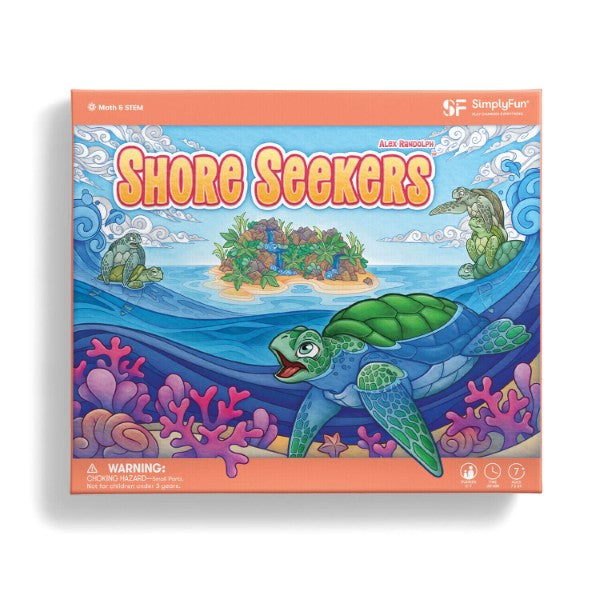
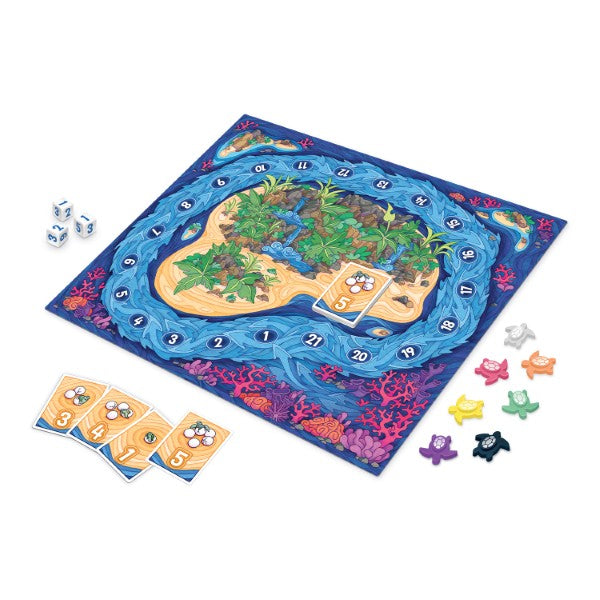
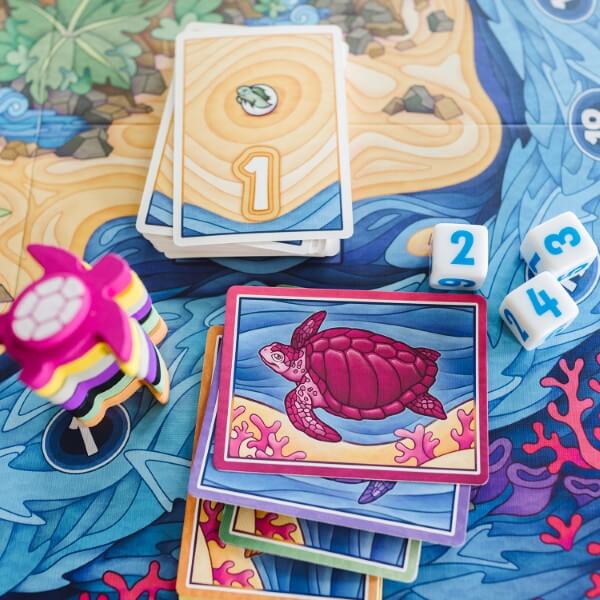
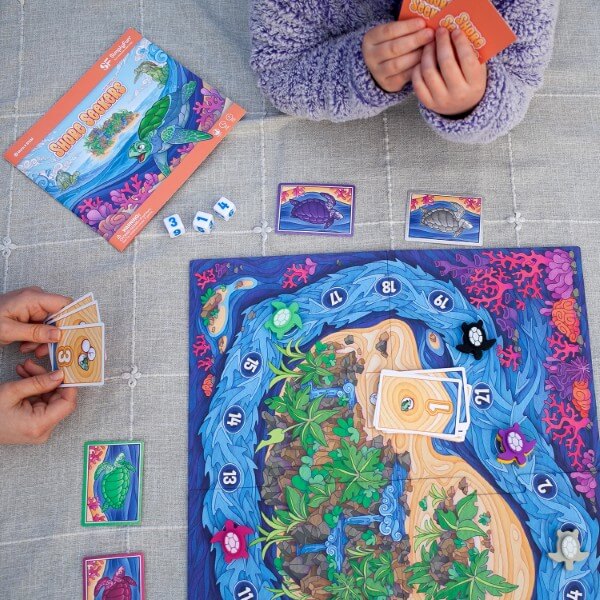
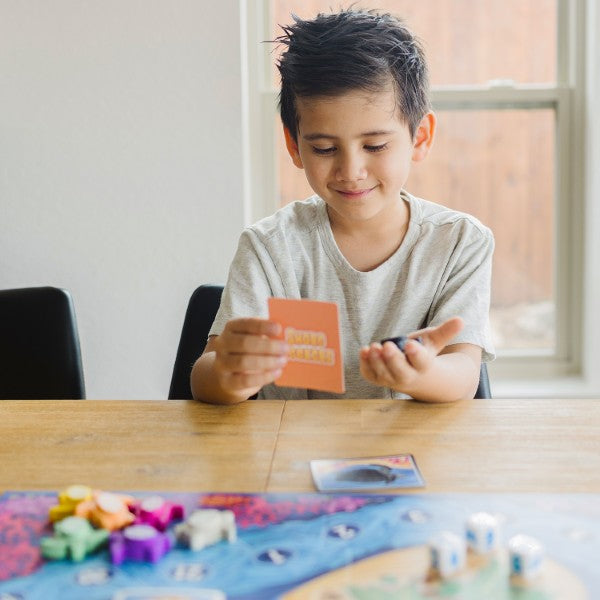
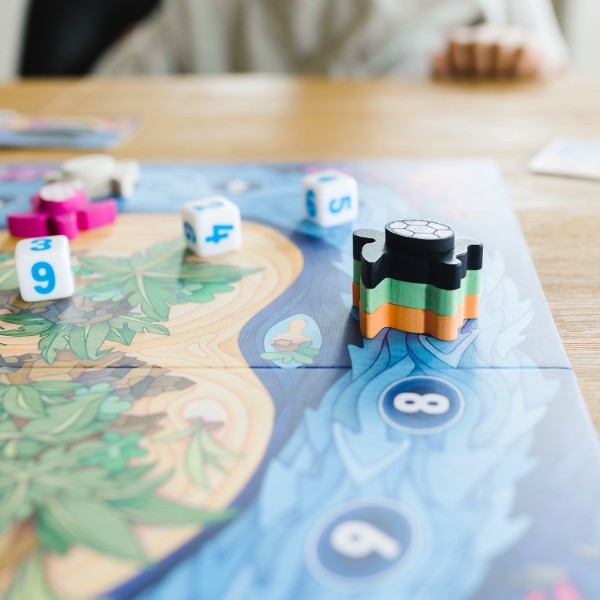



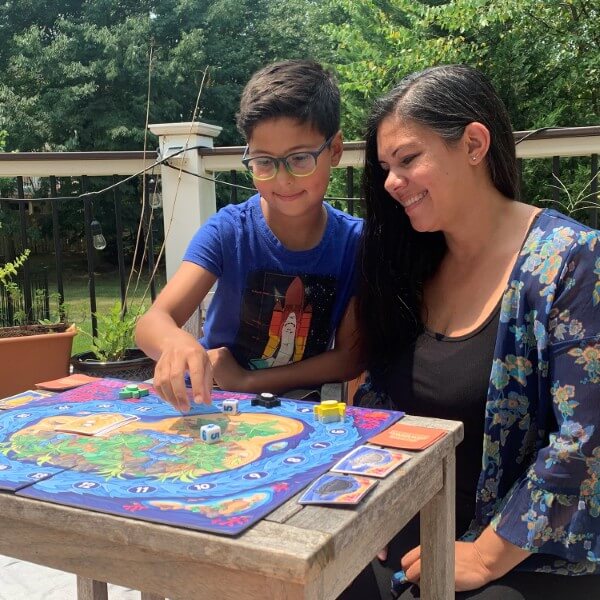

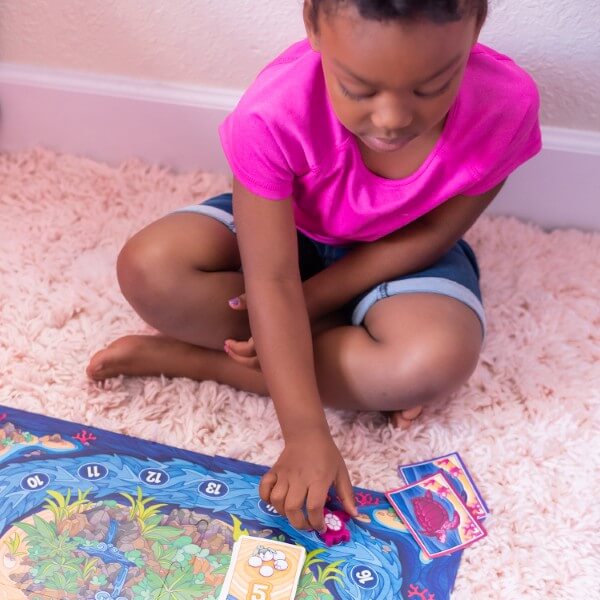
Collapsible content
A game where players use addition and multiplication to determine how far their turtles will swim as they seek the perfect spot on the shore to lay their eggs.
You can play Shore Seekers with 2-7 players, ages 7 and up.
Shore Seekers is good for developing Addition Skills as players roll up to three dice, one at a time, adding the revealed numbers with the goal of reaching a sum equal to or less than seven.
Shore Seekers also helps with Early Multiplication Skills when a player has rolled two or three dice, they multiply the sum of their dice by the number of dice rolled.
• Place the gameboard in the center of the play area.
• Each player chooses two turtles and places them on the coral reef section of the gameboard, near the space marked 1. For this video we are going to share 2 or 3-player gameplay but if you are playing with 4 -7 players then each player chooses only one turtle.
• Remove the seven turtle color cards from the deck, and give each player the cards that match their pawn colors to place in front of themselves as a reminder of their chosen colors.
Place any remaining turtle pawns and their color cards back in the box.
• Sea turtle nests are called clutches. Shuffle the clutch card deck and put the top four cards back in the box unseen. This is to change up the cards available each game.
• Place the remaining 20 clutch cards in a face-up pile on the designated space on the gameboard, the nesting site showing the number 7.
• To see who goes first, each player rolls two dice. Whoever rolls a sum closest to, but not more than 7, will take the first turn. Any tied players roll again.
Players take turns rolling the dice, trying to reach a sum of seven or less. Based on the roll, each player then moves their turtle around the island. Whenever a turtle reaches or passes the entrance to the nesting site (space 21), it lays as many eggs as shown on the top clutch card. At the end of the game, the player whose turtle has laid the most eggs wins.
On your turn, choose and announce which color turtle you want to roll the die for first. When completed, then roll for your second turtle.
Next, roll the dice to determine how many spaces to move your turtle around the island.
Roll the dice one at a time.
The goal is to keep the total sum of the numbers rolled at 7 or less.
With four or more players, you will only roll for your single color turtle.
Roll the first die and then decide whether you want to roll a second die. If your first die roll is high, you may not want to risk rolling the second die. If you choose not to roll a second die, move your turtle the number of spaces indicated on the die.
If you choose to roll the second die, and the total of the two dice is below 7, you may choose to also roll the third die.
If the roll of the second or third die results in a total higher than 7, move your turtle back to the coral reef where you started.
If you are already on the coral reef, nothing happens. This ends your turn, unless you have a second turtle to roll for.
Moving Your Turtle
From the coral reef your turtle’s journey begins on the water path with space 1, moving the total number of spaces indicated by your dice roll. Your turtle does not proceed along the path with dice rolls of 8 or higher and must return back to the coral reef to start their journey again.
Turtles swim clockwise in laps around the island, following the numbers 1–21. Your turtle pawn may pass other turtles along the path.
If you have rolled only one die, move your turtle the corresponding number of spaces forward.
If you have rolled two dice (and the total is equal to or lower than 7), the total sum of the two dice is multiplied by 2, and you move your turtle the corresponding number of spaces forward.
If you roll all three dice (and the total is equal to or lower than 7), the total sum of the three dice is multiplied by 3, and you move your turtle the corresponding number of spaces forward.
Turtle Stack
Turtles may pass other turtles along the way. But if your turtle lands directly on an occupied space, place it on top of the other turtle (or turtles), forming a stack. There is no limit to how many turtles can be stacked.
The player whose turtle is on top will always determine how many dice the other players will roll.
On your turn, if your turtle is not at the top of a stack, ask the player whose turtle is on the top whether they would like you to roll a second or third die.
If the dice roll is lower than or equal to 7, your turtle carries any turtles stacked on top of it as it moves. A turtle only carries other turtles that are sitting on top. It will leave any turtles underneath on the space they started from.
If the total is higher than 7, your turtle and any it is carrying return to the coral reef and unstack. Any turtles underneath stay where they are.
Clutch Cards
Whenever a turtle, or a stack of turtles, lands on or moves past the entrance to the nesting site (space 21), the player collects the top clutch card and places it face down in front of themselves, creating their score pile.
In the case of a turtle stack, only the player whose turtle is on top collects the card. The card shows the number of eggs your turtle will lay.
Clutch cards collected do not need to be kept separate for each of your turtle colors; your score is the total of eggs laid by both your turtles.
When the last clutch card has been taken, the nesting site with the final seven eggs is revealed. Play continues until another turtle or stack of turtles reaches or passes the entrance to the nesting site (space 21). That player then places their turtle (or the top turtle, if there is a stack) in the middle of the clutch with the seven eggs and the game ends.
Each player adds up the eggs on the cards in their score pile to find how many eggs their turtle was able to lay overall. The player whose turtle is sitting on the seven eggs adds those eggs to their final score.
The player whose turtle laid the most eggs wins the game.
In case of a tie, the player with the most clutch cards wins.
Add and multiply your way around the island, collecting eggs for your turtle’s nest with Shore Seekers!


Core Standard*:Math
Math
- Operations and Algebraic Thinking
- Add and subtract within 20. Grade Levels 1st, 2nd

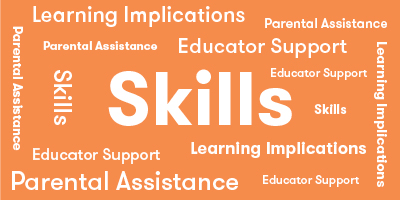
Determine
What Does Child Do To Use Skill In The Game?
Players decide how many dice to roll on their turn as they assess the risk versus reward of rolling one or more dice.
How Parents Can Assist Learning
No special parent support needed. However, if you notice a child consistently rolls dice such that they add up to more than 7, encourage the child to take less risk on future turns. With each roll, ask the child what numbers on the die will enable them to stay under 7. The fewer the possible numbers, the greater the risk.
Learning Implications and Educator Support
No special educator support needed. However, if you notice a child consistently rolls dice such that they add up to more than 7, ask the child to explain their thinking and discuss how they are assessing the risk and reward of rolling more than 1 die or rolling more dice depending on the total of the die/dice they have already rolled.
Predict
What Does Child Do To Use Skill In The Game?
Predicting the probability of rolling dice to keep the total at 7 or below is the primary skill used and developed playing Shore Seekers.
How Parents Can Assist Learning
No special parent support needed. However, if you notice a child consistently rolls dice such that they add up to more than 7, encourage the child to take less risk on future turns. With each roll, ask the child what numbers on the die will enable them to stay under 7. The fewer the possible numbers, the greater the risk.
Learning Implications and Educator Support
Because children may choose to roll up to three dice (one die at a time), they will be assessing the risk of rolling a die that may cause their total to exceed 7 and send their turtle back to the coral reef, versus the reward of not going over 7 and being able to move their turtle or the stack of turtles forward on the game board.
While no special educator support needed, if you notice a child consistently rolls dice such that they add up to more than 7, ask the child to explain their thinking and discuss how they are assessing the risk and reward of rolling more than 1 die or rolling more dice depending on the total of the die/dice they have already rolled.
*Data compiled from CCSSI ELA Standards, WA Science Standards, and Washington Social Studies Standards

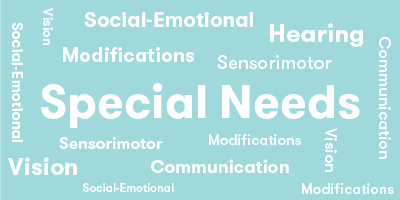
Cognitive
Suggestions for How to Modify Play Experience
For children who are cognitively challenged, use only one die. Other players can use 2 or 3. Children with cognitive disabilities will not understand the probability of getting more than 7 with a second or third roll. They probably will just want to keep rolling each die. Having just one die reduces their risk of over rolling, and they can keep moving forward with each turn.
For lower functioning children, let them play with a partner. They can be the one to throw the die and move the turtle. Their partner can read the number on the die. This will give them practice recognizing written numbers and counting.
For children who can count but cannot add, the game may offer an opportunity to learn about early addition. Give them a piece of paper and a pencil. Let them make marks on the paper to represent the number on the die. They can do the same for the second and possible third die, if needed. Let them count all the marks they made to determine the total amount and whether it is more than 7.
Communication
Suggestions for How to Modify Play Experience
Children with written or oral comprehension concerns will need to have the game demonstrated in a practice game. There is not a lot of communication required in the game, so once they understand the game rules, they should be able to play without difficulty.
Sensorimotor
Suggestions for How to Modify Play Experience
The board and turtle pawns are large, so unless the child has severe fine motor concerns, they should be able to play.
Social Emotional/Behavioral
Suggestions for How to Modify Play Experience
Children who are impulsive may have a tendency to throw the second or third die without thinking. If the child throws a high number on their first roll, the rest of the players can help the child think about the chances of getting a small number on a second throw. Ask them "What numbers could you throw to stay at 7 or less. There are six possibilities on the die. What do you think are your chances?"
Children who get easily frustrated may be disturbed by having to go back to the coral reef, or by ending up within a turtle stack and losing control. Help the child evaluate the risk of each thro to lessen the chances of having to start over. Also discuss the potential benefits of being on the bottom of a turtle pile (not having to go back to the reef if other turtles on top exceed 7) or on the top of the turtle stack (controlling the rolls of the players below).
Vision
Suggestions for How to Modify Play Experience
The numbers on the board are relatively large and the contrast of number against the board is good. The numbers and eggs on the turtle cards, white on yellow, may be a little challenging for children with low vision, but, if needed, another player can identify the number on the card.
Hearing
Suggestions for How to Modify Play Experience
Hearing loss should not problem for playing the game, and communication during the game may be limited. Use of gestures and simple signs can enable the player to interact and show reactions.
*Data compiled from CCSSI ELA Standards, WA Science Standards, and Washington Social Studies Standards

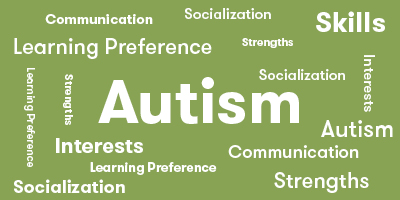
Autism Strengths & Interests
Short Summary of Strengths & Interests
- Probability
- Decision making
- Early addition and multiplication
Is good at matching visual items
Is This Game Appropriate? No
Description
No matching is involved.
Has a good memory for sensory details, including visual, touch, taste and smell
This game is not appropriate
Has a good memory for words, phrases and dialouge
This game is not appropriate
Has a good memory for pictures, numbers and patterns
This game is not appropriate
Likes to put things in order or a sequence
This game is not appropriate
Learns through visualizing or "replaying" actions in their mind
Is This Game Appropriate? Yes
Description
Mentally "replaying" previous rolls of the dice and their consequences may help the child think about the probability of rolling certain numbers on the die.
Likes activities with rules, such as math and phonics
Is This Game Appropriate? Yes
Description
Simple rules and math operations may make this game appealing to children with autism who are good at early math skills.
Is very concrete and literal
Is This Game Appropriate? Yes
Description
The game is concrete, using dice to illustrate numbers.
Learns in small "chunks" (for example, phone numbers are 3 chunks of number xxx-xxx-xxxx that are combined together)
Is This Game Appropriate? Yes
Description
Small "chunks" are involved in game play, as each die represents one number set, and these are added to make a new total as each die is thrown. Additional points are accumulated if more dice are thrown without exceeding 7. Players who successfully throw two dice get to multiply their total by 2, and players who successfully throw 3 dice get to multiply their total by 3. This involves another "chunking" of sets to either multiply or add sets.
Is good at nonverbal reasoning and logic
This game is not appropriate
Likes spatial problem solving
Is This Game Appropriate? No
Description
No spatial problem solving is required, though when a turtle stack is created, players have to analyze their position in the stack to understand the consequences for their turtle.
Can read well with good vocabulary, though may not fully comprehend content
Is This Game Appropriate? No
Description
Shore Seekers does not involve reading. This game is not appropriate
Likes to use and has good fine motor skill
Is This Game Appropriate? Yes
Description
Players need to move their turtles around the path.
Likes established routines or set ways of doing things
Is This Game Appropriate? Yes
Description
The game is played the same way each time, though what happens to a players turtles will vary from round to round.
Likes manipulating, constructing or building things
Is This Game Appropriate? No
Description
No building is involved.
Likes to use and has good musical abilities
Is This Game Appropriate? No
Description
No music is involved.
Likes to use and has good drawing skills
Is This Game Appropriate? No
Description
No drawing is involved.
Autism Special Considerations
Appears to ignore other's communication and/or has difficulty giving eye contact to a communication partner
Is This Game Appropriate for Child with Characteristic? Yes
Can Child with Characteristic Play Game w/o Modification? Yes
Strategies for Developing Compensatory Skills:
It may be helpful to provide a fidget toy to occupy the child's hands in between their turns
Has difficulty understanding complex verbal directions
Is This Game Appropriate for Child with Characteristic? Yes
Can Child with Characteristic Play Game w/o Modification? Yes
Strategies for Developing Compensatory Skills:
The rules around how to move stacking turtles is somewhat complex, so demonstrate with several examples before playing. During play help the child analyze where their turtle is in the pile and what should happen.
Uses vocabulary inaccurately or demonstrates echolalia (repeating another's speech)
Is This Game Appropriate for Child with Characteristic? Yes
Can Child with Characteristic Play Game w/o Modification? Yes
Strategies for Developing Compensatory Skills:
Echolalia should not impact the focus of other players in this game.
Gets stuck repeating a verbal topic or physical actions and/or has difficulty attending to others' actions or topic.
Is This Game Appropriate for Child with Characteristic? Yes
Can Child with Characteristic Play Game w/o Modification? No
Strategies for Developing Compensatory Skills:
A fidget toy may redirect physical actions. Trying changing the topic back to the game by having him focus on the various turtles on the board. For example, talk about how baby turtles have to dig out of the sand and make their way to the ocean.
Has difficulty producing speech/communication
Is This Game Appropriate for Child with Characteristic? Yes
Can Child with Characteristic Play Game w/o Modification? Yes
Strategies for Developing Compensatory Skills:
A little communication is needed when there is a turtle stack. If needed, adults can ask questions, "Do you want her to have to roll a die?" and use the child's nod or vocalization to direct the play.
Has difficulty sequencing multi-step actions and/or doing complex abstract tasks
Is This Game Appropriate for Child with Characteristic? Yes
Can Child with Characteristic Play Game w/o Modification? Yes
Strategies for Developing Compensatory Skills:
The directions are straight forward and actions in the game are simple to understand.
Demonstrates difficulty initiating and maintaining social interactions
Is This Game Appropriate for Child with Characteristic? Yes
Can Child with Characteristic Play Game w/o Modification? Yes
Strategies for Developing Compensatory Skills:
Players will want to communicate about what's happening in the game, but it is not required for game play.
Acts out or demonstrates avoidance behaviors when frustrated, overwhelmed, or needs more sensory input.
Is This Game Appropriate for Child with Characteristic? Yes
Can Child with Characteristic Play Game w/o Modification? No
Strategies for Developing Compensatory Skills:
A player's turtle may get sent back to the coral reef if they exceed a total of 7 on the dice. This may feel defeating to a child. Help the child think ahead of this frustrating experience. Talk about how this can happen in the game. Watch other players' responses, for example, "He's disappointed, but not mad." Help the child prepare, "What are you going to do if your turtle gets sent back to the reef?" When it happens, remind the child of the plan. "Remember, you said you are going to put your turtle back and then sit on your hands until you feel calm again."
Has short attention span for non-preferred activities
Is This Game Appropriate for Child with Characteristic? Yes
Can Child with Characteristic Play Game w/o Modification? Yes
Strategies for Developing Compensatory Skills:
This is a fast moving game, so should hold the child's attention.
Needs sameness or consistent routines and/or has difficulty with transitions from one activity to another
Is This Game Appropriate for Child with Characteristic? Yes
Can Child with Characteristic Play Game w/o Modification? Yes
Strategies for Developing Compensatory Skills:
The game follows the same pattern with each round.
Has difficulty understanding others' feelings, intentions, and the reasons for others' actions.
Is This Game Appropriate for Child with Characteristic? Yes
Can Child with Characteristic Play Game w/o Modification? Yes
Strategies for Developing Compensatory Skills:
Reading others' feelings, thoughts, etc. is not needed for the game. Players do not need to anticipate another player's strategy. The game does offer an opportunity for players to talk about their feelings when they get sent back to the coral reef or get free moves forward with a turtle stack. This can allow the child with autism to practice reading others' verbal, physical and facial expressions.
*Data compiled from CCSSI ELA Standards, WA Science Standards, and Washington Social Studies Standards

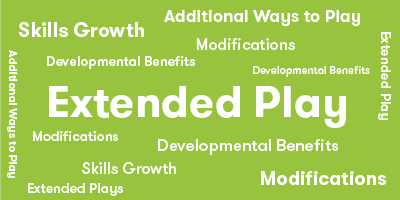
Extra Ways to Play the Game
If a player goes over 7 with a throw, other players get to move forward the amount over 7. For example, if a the player's total rolls equal 11, the other players all move their turtles 4 spaces forward. The player does not have to send their back to the coral reef.
Materials Needed
No additional materials needed
Developmental Benefits
This adaptation will change how players assess risk and reward. Additionally, for children who find it overly frustrating to have their turtles return all the way to the coral reef, this expansion will reduce that frustration by making the "penalty" of going over 7 less severe.
*Data compiled from CCSSI ELA Standards, WA Science Standards, and Washington Social Studies Standards
Game Details
- 1 Gameboard
- 7 Turtle Pawns
- 7 Turtle Color Cards
- 24 Clutch Cards
- 3 Dice
- 1 Rules Booklet
- Choosing a selection results in a full page refresh.
- Opens in a new window.















